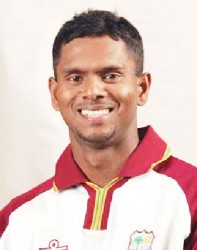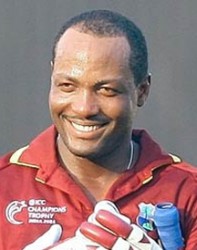TO use the contemporary idiom, there will be an elephant in the room when Clive Lloyd and his fellow selectors choose the West Indies team for the first Test against Australia in Dominica June 3-7.
Since it applies to a player with the nickname of an altogether more ferocious animal, the expression may be somewhat incongruous but, however much the panel finds it difficult to determine the immediate future of Shivnarine Chanderpaul, a cricketer with an outstanding past, the issue cannot be dodged.
The questions to be answered are obvious.

Do Lloyd and his colleagues interpret the sudden, dramatic slump of the one, consistently reliable West Indies batsman during the continuing period of decline as the immediate end to his extraordinary career?
Even as he turned 40 last August, it appeared the slender left-hander, tagged “Tiger” for his fierce, single-minded resistance in the face of repeated lost causes, could well carry on to become the game’s Methuselah.
A month after the birthday that carried him into his fifth decade, he bumped up his aggregate with scores of 85, 84 and 101 without being dismissed in two Tests against Bangladesh in the Caribbean.
With the abruptness of a Caribbean sunset, he has had to face the inevitability that, whatever the lyrics of the song might claim, life does not begin at 40.

He remains fit and agile in the field; batting is an altogether different matter for those depending on their reflexes and eyesight to deal with a five-and-a-half ounce of leather ball aimed in their direction from a distance of less than 22 yards. Pakistan’s Misbah-ul-Haq is presently the only other Test cricketer of such vintage.
In his last six Tests, Chanderpaul managed 91 runs in five innings in South Africa last December and January and 92 in six against England over the past month. He has succumbed to eight different bowlers of various types.
Set against his overall record, the inference from such figures is undeniable.
Even now, after 164 Tests (more than any of the 302 players who have worn West Indies colours in their 87 years of Test cricket), he tallies 11,867 runs, averages 51.37 and has 30 hundreds to his name, all carefully achieved with neat deflections and gap-seeking strokes from a ungainly, exaggerated open stance that defies reason and instantly identifies him.
It isn’t worth contemplating how much worse the West Indies’ downfall would have been without him; now the reality is that, whether selected against Australia or not, a career in its 22nd year is winding down. He will eventually return to his home in Miami, carrying with him his memories and an ambition to introduce the game to schools in Florida, a scheme that is already up and running.
Before he does, the determination that has always been the most significant characteristic of a boy raised to be a cricketer by his father and uncle in the humble Guyana village of Unity might just drive him to a final flourish against the Aussies.
They have always been favoured opponents. In 20 Tests against teams successively led by Mark Taylor, Steve Waugh, Ricky Ponting and Michael Clarke, his average touches 50; at his home ground of Bourda in Guyana in 2002, in his first innings against them, he sped to 100 off 69 balls, then the third fastest on record.
While the selectors consider the entirety of his career in making their decision, the most pertinent issue likely to occupy their attention is whether the young alternatives are yet ready to face up to the strongest bowling attack in Test cricket.
As the West Indies Cricket Board (WICB), unlike all others, continues to separate its first-class tournament from home Tests, it precludes a ready appraisal of any player required in case of an incumbent’s injury or loss of form.
When 21-year-old Shai Hope was chosen for his debut in the final Test against England – and placed in the unfamiliar role of opener – he had played no serious cricket for a month. It was hardly proper preparation.
The list of prospective replacements is short as it is; by the Dominica Test, none would have had a first-class match for 41 days.
It is a scenario likely to retain Chanderpaul his place. The better option for introducing any new, young player would be on the tours of Zimbabwe and Sri Lanka later in the year.
In the widespread discussions on the subject (we are, after all, dealing with a special, long-standing, committed West Indian cricketer), an absurd, if not surprising, idea has gained currency.
It is that Chanderpaul be given the two Tests solely to allow him the opportunity of adding the 47 runs he needs to surpass Brian Lara’s 11,912 runs as the most in West Indies’ Tests.
The unfortunate upshot is that if he is, indeed, picked – as is likely in the circumstances – it will be perceived as precisely for that reason. It would be a pointless distraction, serving no purpose except to one dimensional statisticians.
It certainly wouldn’t establish who is better between two complete opposites whose left-handedness and extraordinary records are the only things they have in common.
Lara was, quite simply, a genius to whom batting was second nature. Even compiling unimaginable record scores of 500 not out, 400 not out and 375 seemed to require minimal effort, maximum enjoyment.
Chanderpaul was clearly not endowed with such natural talent; he has battled for every run. At his best scrapping against the odds, he relishes every crisis that has come along, readying himself for the challenge with his curious ritual of hammering a bail into the pitch to mark his guard followed by various fidgets before settling into the most ungainly stance in the game.
Lara is eight years into his retirement, forced on him after the team’s failure in the 2007 World Cup under his captaincy. Chanderpaul’s is soon upon him.
For different reasons, it is unlikely that we will ever see their likes again.









